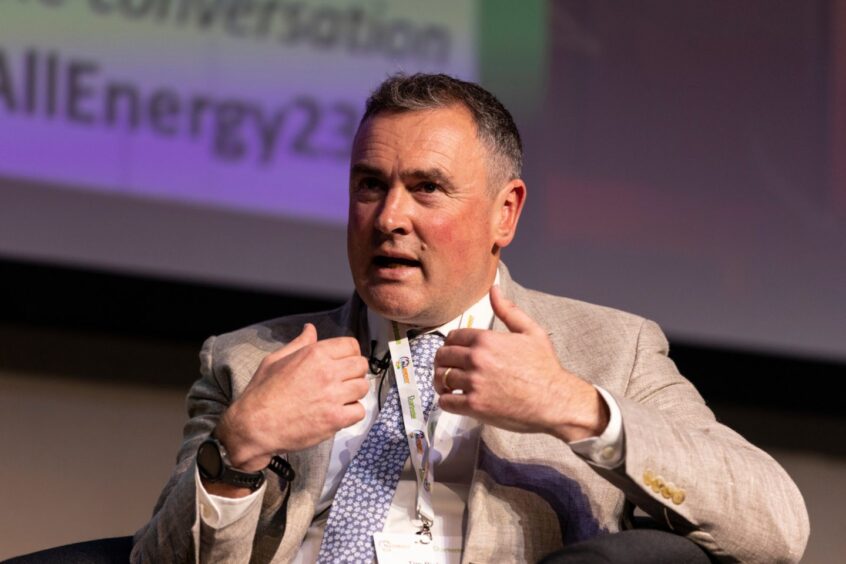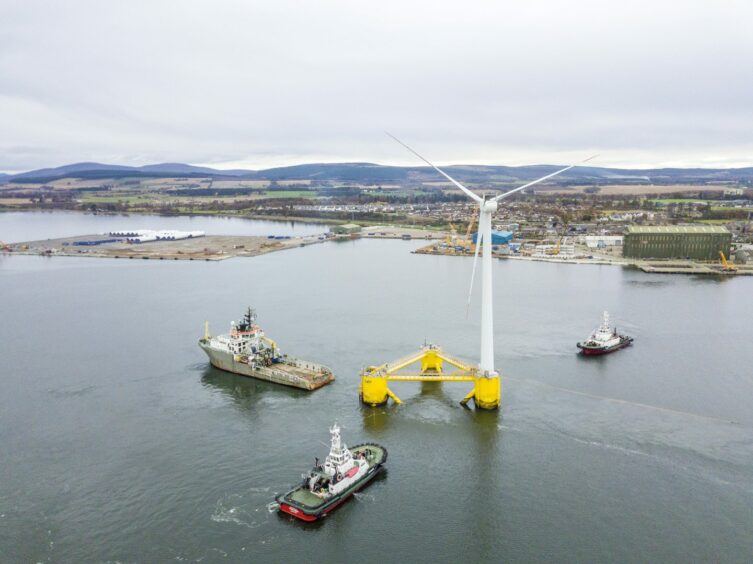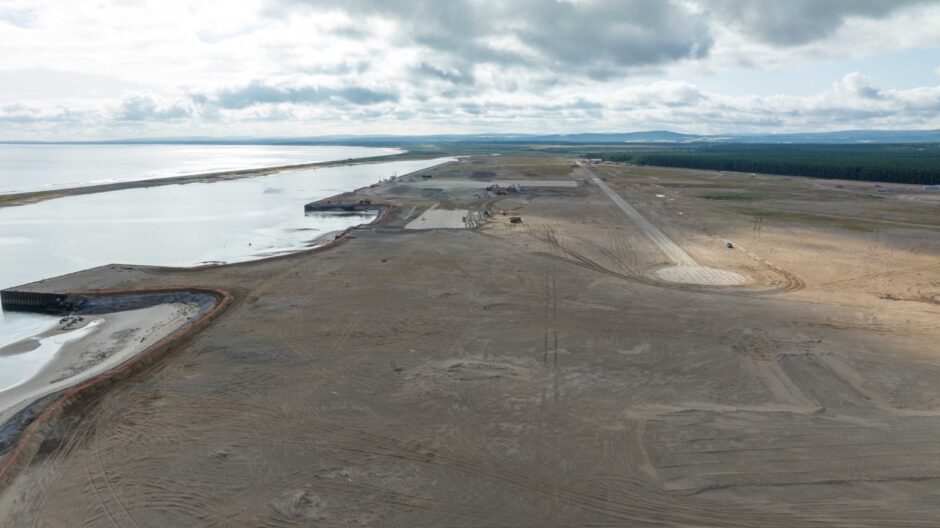 © Supplied by All-Energy
© Supplied by All-Energy In the words of the UK’s former Offshore Wind Champion, it has been something of a ‘rollercoaster’ year for the sector.
The period saw great strides, not least the publication of his independent report on how to accelerate deployment across the sector and the start of a reckoning with infrastructure expansion and grid connection.
Yet it has also seen rampant inflation and financial hurdles halt projects on both sides of the Atlantic. In the UK this culminated in a total lack of offshore wind bids as part of the fifth allocation round (AR5) of CfDs – widely seen as the “biggest failure” in UK green energy since 2015, according to industry figures.
Speaking to Energy Voice on the sidelines of the ORE Catapult’s Supply Chain Spotlight event in Edinburgh in mid-December, Tim Pick – now chairman of the Offshore Wind Growth Partnership – suggests the outcome was inevitable.
“It was coming from Christmas time [2022]. I have a lot of sympathy with the government. They couldn’t reopen a live auction otherwise they’ll just get asked to do it every time.
“I’ve described this almost as a game of chicken, basically government saying we have to stick these parameters, industry saying they’re wrong and – bang. And who suffers from that? Effectively we as citizens because you delay all the screened deployment.”
Yet the outcome appears to have been something of a teaching moment. For its part, industry proved the sector would not be loss leaders on price, exercising much-needed capital discipline. The government too has listened to recommendations in the wake of the outcome, upping strike prices to higher levels for next year’s AR6.
Strike prices for the auction will increase by 66% from £44/MWh to £73/MWh for fixed bottom wind, and by 52% for floating projects from £116/ MWh to £176/MWh.
“I see it as a moment of correction,” says Mr Pick.
“You had a bit of a front-page disaster on offshore wind in AR5. And the response to that has been really robust from government, which tells you they stood back and went: ‘Oh my God, we actually really want this stuff.’”
In doing so, the government has “bitten the bullet with the public” he says.
A separate pot for offshore wind will also help ensure as much shovel-ready capacity as possible is able to bid. Further details on the allocated budget for that pot won’t emerge until spring, but he remains confident the sector should not worry.
“Everyone is saying the budget needs to be there. I mean, why would you raise the strike price and then do something dumb on the budget? It just doesn’t make any sense.
“If you think about the year we’re going into, an election year, you would hope that there would be a real motivation to get this right.”
“I think it’s caused everyone to just take stock and we’ve come out of it really well.
“My understanding – though I’m not in the room anymore for these conversations – is the relationship between industry and government is in a really good place because we’ve all had this ‘come to Jesus’ sort of moment.”
Port priorities
That’s in no small part due to his state-of-the-sector report released in April, which pointed to issues around grid access and consenting as the major limiting factors in plans to expand offshore wind.
“I’m really proud of the way those things have been received,” he said.
“We were appointed at a moment in time in Boris Johnson’s government where I think they were looking for some new ideas and some fresh and independent thinking and I hope that’s what we’ve done.
“At the end of the day, it’s just my view and I’m not saying it’s perfect. They don’t have to accept all the recommendations, but it’s nice that they’re doing some of them.”
Alongside the grid, his messages around the importance of the manufacturing and supply chains are also seemingly being heeded.
Chief amongst those is Mr Pick’s view that offshore wind should have similar treatment to other industries, like steel, automotive or aerospace which “seem to get more direct support” for their supply chains.
Most specifically, he is concerned about the need for rapid action on the UK’s port infrastructure.
“I’d love a rebalancing towards more supply chain growth and more jobs and that’s why I’m very worried about the port side of it, because ports are quite key to that story.”
In particular, he refers to larger sites that can provide sizable areas of laydown and marshalling space to support construction, perhaps with wet storage capacity for floating foundations. And while recent green freeport announcements and new investment in the likes of Ardersier are to be welcomed, he says much more still needs to be done.
“That’s the really gnarly, difficult part of this – and I don’t think we found the way to solve that yet.
“Ardersier is a great story, but it feels a little bit of a one off right now. If you look at some of the other developments around the country – in Scotland you’ve got Scapa Flow, you’ve got Invergordon all looking to expand their footprint.
“But they’re not businesses that can just throw money at this stuff. They need some level of support.”
What form that would take is negotiable, but Mr Pick suggests it would follow some kind of capacity model – “not a CFD, but something that helps with that” – and likened it to the PPP structures used to build hospitals, or the grid’s capacity market.
Ideally, such a guarantee wouldn’t be used – but it would provide a necessary safety net to “catalyse” investment which is needed now.
“Ports are pretty ingenious companies, so they don’t sit if they have a period where there isn’t much offshore window activity going on, they won’t just let that asset sit fallow.”
These investments wouldn’t have to be made all at once, but given the length of time to finance, consent and build port infrastructure he says something of this nature is needed “ASAP.”
“You already have projects in Scotland and in the Celtic Sea coming up towards CFD bidding, also some of the smaller test and demonstration projects in the Celtic Sea and some of the INTOG projects here.
“The ports that can crack that sort of serial production and assembly of floating wind will just gain us some sort of momentum in my view – and it will be quite hard to come at it later.
“We’ve seen like we’ve seen that in fixed bottom with some fantastically successful ports at places like Esbjerg or Cuxhaven. I think there’s a there’s an urgency point to this.”
Failure to build that capability in time to deliver major UK projects – something Pick has already criticised in respect of the two floating projects already operational – would be “highly damaging” to the reputation and goals of the sector, he ventures.
He points to the three consented floating wind farms already lined up to bid for CfD support as part of AR6.
“Let’s say they get through and they get CFD, and let’s say they tow in the units from somewhere else. That’s going to be highly damaging to confidence in the sector.
“It’s going to be embarrassing for politicians. And maybe we’re too late for them because they’re very near-term projects. We’ve got to have a plan beyond that.”
‘We don’t need an Esbjerg’
With that said, he is also realistic about expectations. Even with new facilities from the likes of SeAH in Teesside, the UK lacks major steel-rolling capabilities to manufacture towers and monopiles at the scale required, or indeed to produce enough floating foundations to meet apparent demand.
“But there’s a lot of work around the assembly and integration of that – and once you start doing it, there will be little innovative companies all around pushing the boundaries.
“If you’re not even doing that in-country, you’re not going to get that catalytic effect.
“We don’t need an Esbjerg, but what we do need is some places where we can do more of that sort of assembly activity – and hopefully act as a catalyst for other jobs and other growth.”



